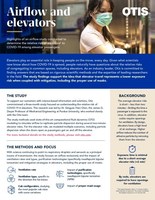Otis Releases Elevator Airflow Study Findings: COVID-19 Exposure on Elevator Ride is Low Risk with Simple Mitigation
Otis Worldwide Corporation (NYSE: OTIS) released findings from a three-month study examining elevator airflow and COVID-19 exposure risk. The research indicates that elevator rides pose a relatively low risk of virus exposure, comparable to shopping in a supermarket, when riders wear masks and air purification systems are installed. Conducted by Dr. Qingyan Chen at Purdue University, the study emphasizes the importance of elevator ventilation and suggests that proper mitigation strategies can significantly reduce exposure risk by up to 80%. More details are available on the company's website.
- Study shows low COVID-19 exposure risk in elevators, comparable to supermarket trips.
- Mitigation strategies can reduce exposure risk by up to 80%.
- Elevators have significant air exchange, enhancing safety.
- None.
Insights
Analyzing...
FARMINGTON, Conn., Jan. 27, 2021 /PRNewswire/ -- Otis Worldwide Corporation (NYSE: OTIS) today released the results of a three-month academic study that investigates how elevator airflow affects potential exposure to the COVID-19 virus and a science-based approach for how to mitigate that exposure in elevators. Findings show the significant amount of air exchange present in most elevators combined with simple mitigation strategies, including all riders properly wearing a surgical-style mask1 and the installation of a common type of air purification2 system, puts an elevator ride on the lower end of the exposure spectrum. The study concludes that a short elevator ride represents a relatively low risk of exposure compared to several everyday activities – less than outdoor dining and comparable to a trip to the supermarket – when simple mitigation is in place. Otis is the world's leading company for elevator and escalator manufacturing, installation and service.
With science continuing to point to respiratory droplets and aerosols as a principal means of transmission, the study focused on airflow and the impact of ventilation rates and types, purification technologies (specifically needlepoint bipolar ionization) and the proper use of masks.
The study was led by Dr. Qingyan (Yan) Chen, the James G. Dwyer Professor of Mechanical Engineering at Purdue, who is widely recognized for his research into the spread of infectious disease through indoor air systems – and how to prevent it. Dr. Chen uses sophisticated computational fluid dynamic (CFD) modeling in his research, which has focused on indoor environments, aircraft cabins and building design and analysis. He has published three books and over 470 journal and conference papers. He previously served as Principal Director of the Federal Aviation Administration's Center of Excellence for Airliner Cabin Environment Research.
Dr. Chen and team looked at likely exposure to the virus, which can be quantified by the frequency, duration and intensity of exposure. The duration of a typical elevator ride is short – usually less than a minute. Multiple scenarios of two-minute elevator rides were modeled to assess relative risk.
Intensity of exposure is impacted by the level of air exchange or ventilation. Elevators have significant air exchange by design, compared to many other indoor spaces, and are required by code to have openings for ventilation. Many elevators also have fans to increase ventilation.
"Air exchange is important. Our findings concluded that the higher ventilation in an elevator, relative to the compared activities, results in lower exposure opportunity. If all passengers properly wear masks, the relative exposure risk drops
Qualitative comparisons place riding an elevator with all passengers wearing masks in a low exposure risk category, with a relative risk similar to that of shopping in a supermarket.
"Elevators are an essential part of everyday life for many, often the first leg in your journey and the last on your route home. We know many passengers have questions about exposure risks associated with riding an elevator, and we want to provide answers verified by science," said Robin Fiala, Vice President, Marketing and Sales. "We're sharing the study results broadly in advance of publication to keep riders well-informed and limit misconceptions."
More details of the elevator airflow study, including a technical whitepaper, are available on otis.com. The full technical report, authored by the Purdue University research team, is available by request and expected to be published in a peer-reviewed academic journal later this year.
About Otis
Otis gives people freedom to connect and thrive in a taller, faster, smarter world. The global leader in the manufacture, installation and servicing of elevators and escalators, we move 2 billion people a day and maintain more than 2 million customer units worldwide – the industry's largest Service portfolio. You'll find us in the world's most iconic structures, as well as residential and commercial buildings, transportation hubs and everywhere people are on the move. Headquartered in Connecticut, USA, Otis is 69,000 people strong, including 40,000 field professionals, all committed to meeting the diverse needs of our customers and passengers in more than 200 countries and territories. To learn more, visit www.otis.com and follow us on LinkedIn, Instagram, Facebook and Twitter @OtisElevatorCo.
1All riders properly wearing (nose and mouth covered) surgical-style masks as recommended by the World Health Organization as compared to no riders wearing masks.
2Air purification called needle point bipolar ionization (NPBI) as compared to elevators without NPBI air purification.
Contact: | Ray Hernandez |
+1-860-674-3029 | |
![]() View original content to download multimedia:http://www.prnewswire.com/news-releases/otis-releases-elevator-airflow-study-findings-covid-19-exposure-on-elevator-ride-is-low-risk-with-simple-mitigation-301216381.html
View original content to download multimedia:http://www.prnewswire.com/news-releases/otis-releases-elevator-airflow-study-findings-covid-19-exposure-on-elevator-ride-is-low-risk-with-simple-mitigation-301216381.html
SOURCE Otis Worldwide Corporation








